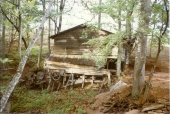









"Never doubt that a small group of thoughtful, committed citizens can change the world; indeed, it's the only thing that ever has."-Margaret Mead "The only thing worse than being blind, is having sight but no vision."-Helen Keller





Living in Anjou , France,
For the many not for the few
http://www.permies.com/t/80/31583/projects/Permie-Pennies-France#330873














This is true. Sound's like your creek is just big enough to be in that category. Most perennial flows will have some form of regulation. This is particularly true if 1.) you are diverting the entire flow, or 2.) the stream is fish bearing.there used to be a whole heap of legislation
"Never doubt that a small group of thoughtful, committed citizens can change the world; indeed, it's the only thing that ever has."-Margaret Mead "The only thing worse than being blind, is having sight but no vision."-Helen Keller


















yeah. Getting direct mechanical force to get a flywheel spinning and run a sawmill or a grain mill is VERY doable. The problem, as you state is translating that into electricity. For that to be efficient/worthwhile, you either need a lot more head from what I know. I don't know of any generator that could translate such low head and low volume into electrical power effectively. I might be wrong, but I've never heard of anybody doing it besides the engineers at Gaviotas, and they had more volume in their low head systems. And those guys were really high end thinkers/designers to come up with their power generator.Now the problem is turning that torque into electricity. I would think a custom built generator would be required to get the most juice from all that torque.
"Never doubt that a small group of thoughtful, committed citizens can change the world; indeed, it's the only thing that ever has."-Margaret Mead "The only thing worse than being blind, is having sight but no vision."-Helen Keller












 best of luck mate
best of luck mate Living in Anjou , France,
For the many not for the few
http://www.permies.com/t/80/31583/projects/Permie-Pennies-France#330873














"Never doubt that a small group of thoughtful, committed citizens can change the world; indeed, it's the only thing that ever has."-Margaret Mead "The only thing worse than being blind, is having sight but no vision."-Helen Keller























You are right to point out the water coming up the back of the wheel. It looks like there are two possibilities for that problem. 11.) The water underneath is being picked up by the cups as the wheel spins, which means the wheel needs to be higher. 2.) The design of the cups is flawed as they are not getting rid of all their water after the vertical drop. The water coming up the back is a huge source of inefficiency as the weight will be slowing the wheel's potential to spin. Good eye.quite a lot of water coming up around the back as the wheel turns, i'm thinking this is not a good thing and you really need the buckets to empty as much a possible before they return to the top,
I'm not sure. The thicker wheel would guarantee that you get benefit from all the water and gravity, where as a thinner wheel will have more splash off, or water that misses it altogether. If your bushing is good (so there is limited friction in spinning your axle), the width shouldn't matter much for creating inefficiencies, if that is why you think that a wide wheel is not best.i guess the wheel width would have to be matched to the water outlet and was thinking a thinner wheel would be best.
"Never doubt that a small group of thoughtful, committed citizens can change the world; indeed, it's the only thing that ever has."-Margaret Mead "The only thing worse than being blind, is having sight but no vision."-Helen Keller














"Never doubt that a small group of thoughtful, committed citizens can change the world; indeed, it's the only thing that ever has."-Margaret Mead "The only thing worse than being blind, is having sight but no vision."-Helen Keller








Interested in prospect of wwoofers coming to in summer to work on land/ building cob/ strawbale/ bamboo etc structures (600 sq metres, 0.6 hectare)
rocket stove in garden to fire earth-kiln for raku - also as bread oven! have potters kick-wheel. Build water feature, establish veg beds - and raised beds email me yr experience




Living in Anjou , France,
For the many not for the few
http://www.permies.com/t/80/31583/projects/Permie-Pennies-France#330873













Living in Anjou , France,
For the many not for the few
http://www.permies.com/t/80/31583/projects/Permie-Pennies-France#330873









|
If we don't do the shopping, we won't have anything for dinner. And I've invited this tiny ad:
Freaky Cheap Heat - 2 hour movie - HD streaming
https://permies.com/wiki/238453/Freaky-Cheap-Heat-hour-movie
|




